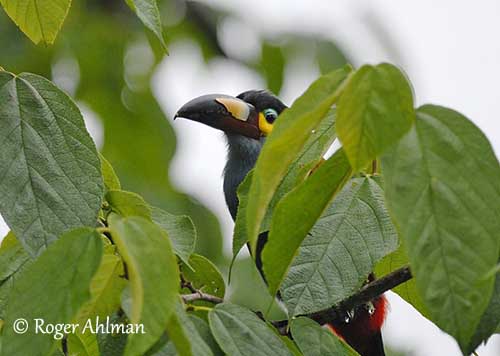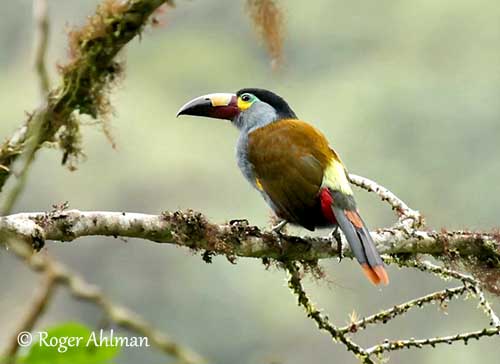
Fr: Toucan montagnard
Ang: Plate-billed Mountain-Toucan
All: Leistenschnabeltukan
Esp: Tucán Piquiplano
Ita: Tucano di monte beccopiatto
Nd: Zwartkruinbergtoekan
Sd: bleknäbbad bergtukan
Photographers:
Roger Ahlman
Pbase Galleries Peru and Ecuador
Didier Buysse
Vision d’Oiseaux
Text by Nicole Bouglouan
Sources:
HANDBOOK OF THE BIRDS OF THE WORLD Vol. 7 by Josep del Hoyo-Andrew Elliott-Jordi Sargatal – Lynx Edicions – ISBN: 8487334377
Neotropical Birds – Cornell Lab of Ornithology
Wikipedia, the free encyclopaedia
Plate-billed Mountain-Toucan
Andigena laminirostris
Piciformes Order – Ramphastidae Family
INTRODUCTION:
The Plate-billed Mountain-Toucan is a member of the genus Andigena, alongside three other species. They occur along the Andes from Colombia and Venezuela to Bolivia. They have dense plumage and the bill has broader base and is less deep than in other species. They have a peculiar bill pattern with patchy marks and bright splotches.
These toucans give long, loud songs, including the longest notes recorded in Piciformes.
DESCRIPTION OF THE BIRD:
Biometrics:
Length: 46-51 cm
Weight: 275-355 g
The adult has brown and green upperparts, except the pale yellow rump. The tail is blackish with chestnut tips to central rectrices.
On the underparts, neck sides and chin to belly are blue-grey, with yellow patch on the side of the flank, often concealed by the folded wing. Thighs are chestnut and undertail-coverts are red.

On the head, forehead, crown, nape and hindneck are black. The facial skin is blue above and behind the eye, and yellow on lores and cheeks, and joins the blue skin behind the eye, creating a small green area.
The large bill is about 8-10 centimetres long. Base of upper mandible and half of the lower mandible are dark red. There is a bony, rectangular, ivory-coloured plate portion near the dark red base of the upper mandible. Rest of bill is black.
The eyes are reddish-brown. Legs and feet are pale blue-grey. The feet are zygodactylous, with two toes forwards and two toes backwards.
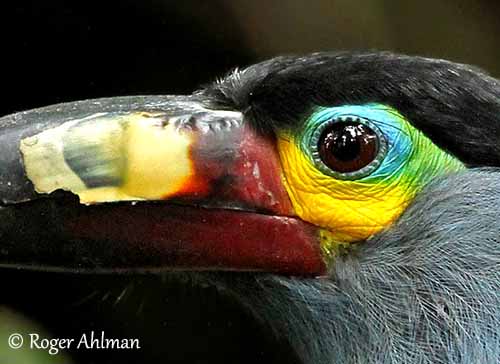
The female has similar plumage, but she is slightly smaller than male, and she has shorter bill.
The juvenile/immature has duller and softer plumage than adults, with browner upperparts and greyer underparts. The bill is mostly grey-black with yellow area instead of the bony plate.
RANGE:
The Plate-billed Mountain-Toucan occurs on W Andes from SW Colombia, S to C Ecuador, and possibly as far as Chanchan area in Peru.
HABITAT:
The Plate-billed Mountain-Toucan frequents humid and wet montane forests, but also secondary growths with bromeliads, mosses and epiphytes.
This species usually occurs between 1300 and 2500 metres of elevation, but it can be seen sometimes below 300 metres and rarely up to 3200 metres.
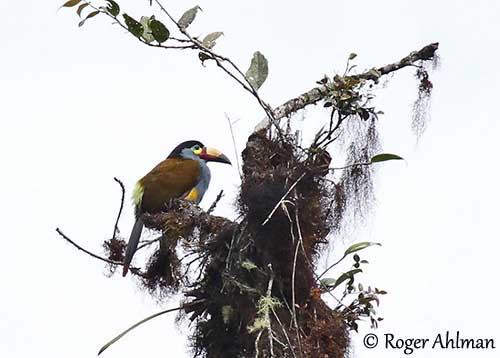
CALLS AND SONGS: SOUNDS BY XENO-CANTO
The Plate-billed Mountain-Toucan is very vocal, and male and female often duet. They utter loud rattles and clicks which can be heard over a kilometre away. Rattles vary from 1 to 3 per second and the birds also make bill-snapping.
They also produce squeak notes “ddrak”, probably as contact call. Both mates communicate through “ek-ek” calls as they are close together. The female has higher-pitched voice.
During interactions, they often perform loud wing-flapping.
The song is a braying series of “eeeeaah” notes, sometimes mixed with bill-snapping sounds. Rattles can be vocal or made by the tongue inside the bill. These sounds may lead to the song.
BEHAVIOUR IN THE WILD:
The Plate-billed Mountain-Toucan feeds mainly on fruits of numerous plant and trees species, up to 100 different species. However, during the nesting period, they also take a variety of insects (beetles and others), snails, small birds and eggs, and occasionally rodents. The long hook-tipped bill is a well-adapted tool.
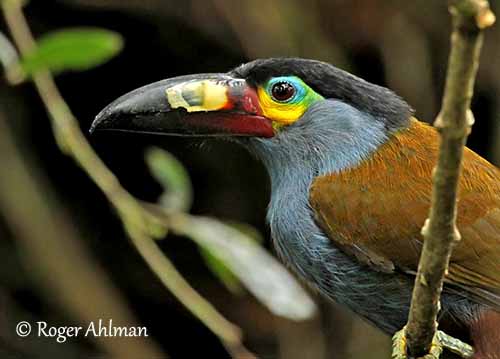
While feeding on fruits, the largest items are broken up by holding them with the foot and tearing with the bill. Smaller fruits are usually swallowed whole, and the largest seeds (avocado) are regurgitated.
It disperses the seeds of several plants, including Faramea affinis, a mountain shrub, and the palm Prestoea acuminata. This species plays an important ecological role.
They breed when fruits are most abundant. They are monogamous.
The Plate-billed Mountain-Toucan performs ritual courtship displays during which the bright plumage and head pattern are enhanced. The red undertail-coverts are erected, the yellow patches of flanks are spread, and the male cocks the tail which is flicked, cocked and lowered, in order to display the red undertail-coverts.
Courtship feeding by male to female is common, and usually, the female begs for food to the male. The copulation lasts 15-20 seconds.
The mates may call each other in duets, with male uttering loud, repeated “tryyyyyyyyk” while the female gives drier calls “ttttttttttt”.
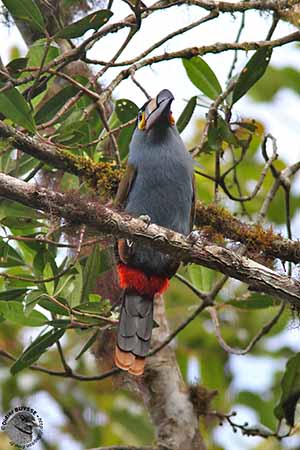
The Plate-billed Mountain-Toucan is resident in its range, but some altitudinal and other movements are observed in Colombia. They move in groups of 20-25 birds to lower levels in August, probably related to fruit availability.
The Plate-billed Mountain-Toucan performs slightly undulating flight with series of wingbeats interspersed with glides.
While foraging in trees, it bounds and jumps, leaps and hops upwards in tree branches. It may also cling to small branches to reach the fruit with its long bill.
REPRODUCTION OF THIS SPECIES:
The breeding season occurs between March and October in Colombia and between June and September in Ecuador, with peak in June and July when fruits are most abundant.
The nest is a hole in dead tree or stump, and even utility poles. The birds excavate to adapt the entrance, and often continue during the nesting period. There is no lining, but some wood chips created by the enlarging of the entrance, and various regurgitated seeds may be added. The nest is placed between 6 and 30 metres above the ground.
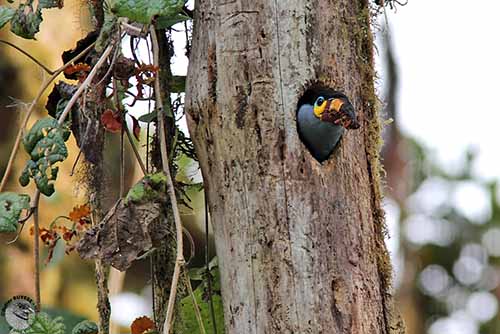
The female lays 2-3 shiny white eggs about two weeks after finishing the nest. The incubation lasts 16-17 days shared by both adults, with female mainly at night.
At hatching, the chicks are blind and naked, and the bill appears really two weeks after hatching. They are fed by both parents but more often by the female about 1-2 times/hour. They are fed first with small items, and later with larger fruits, although the male provides more insects.
The chicks open their eyes at 4 weeks old and fledge between 46 and 60 days after hatching, usually 46-51 days. They still depend on adults for 2-3 weeks. If the female starts a second brood, they are chased away from the territory.
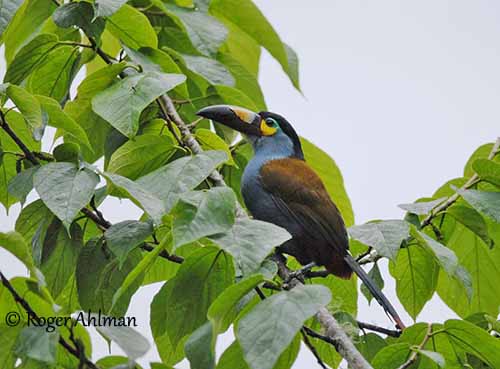
PROTECTION / THREATS / STATUS:
The Plate-billed Mountain-Toucan has restricted range that is continuously decreasing in size due to habitat loss and especially deforestation, human settlements, cattle-grazing, mining and various plantations. This species is also threatened by illegal international cage-bird trade.
The population is declining throughout the small range, and the Plate-billed Mountain-Toucan is currently classified as Near Threatened.
